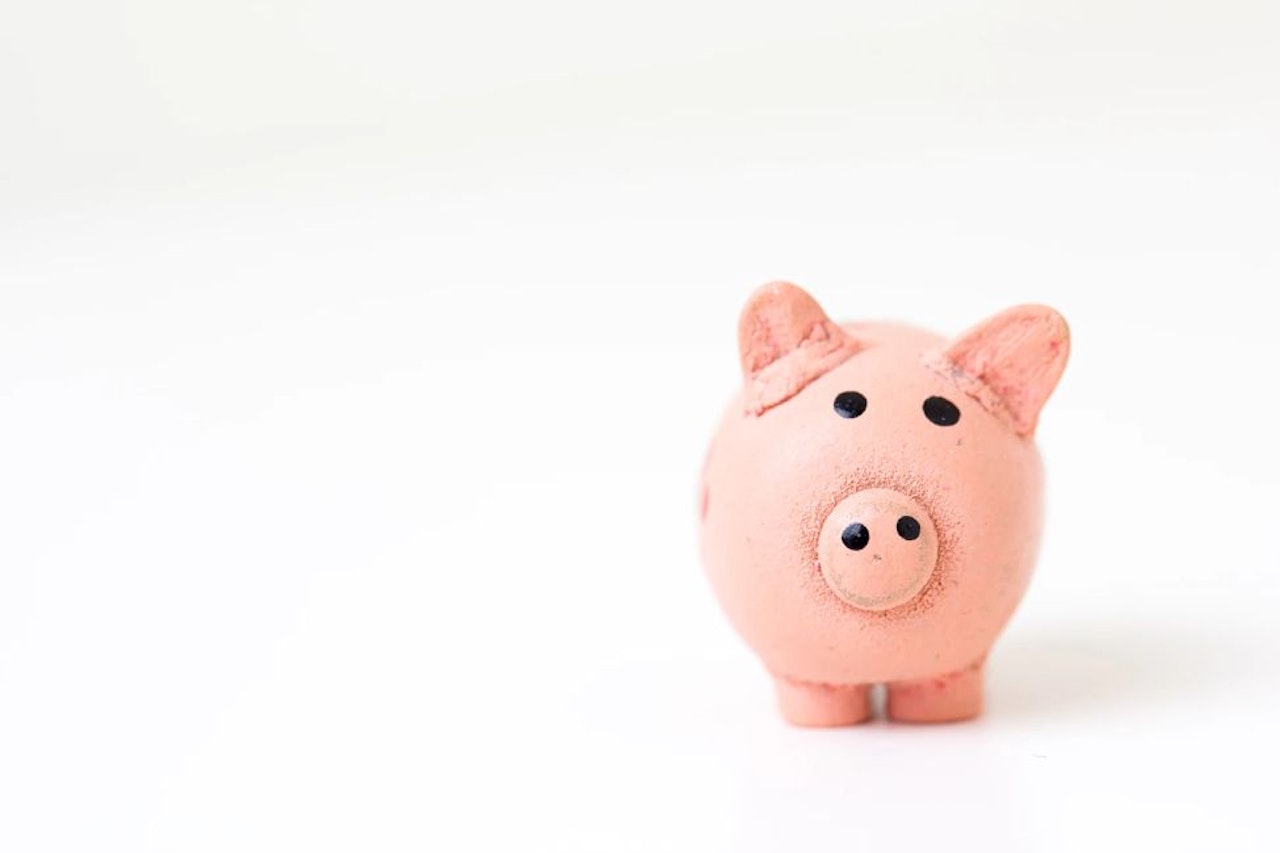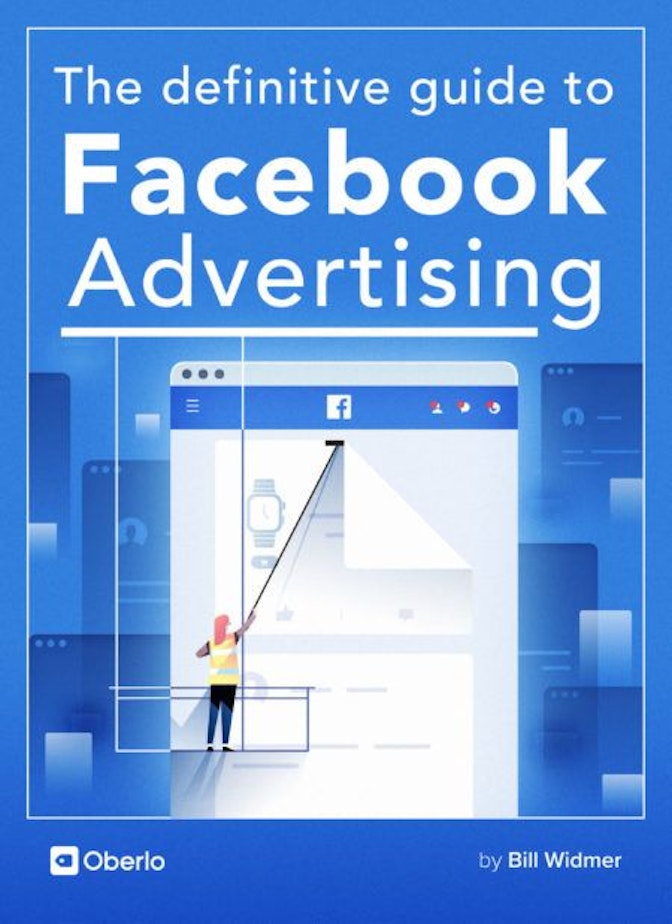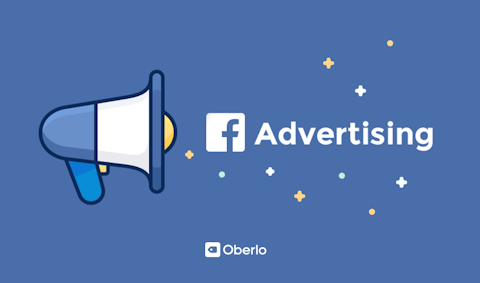Facebook ads can be a money machine.
It’s every entrepreneur’s dream to create something that makes more money than what you spend.
Of course, you can only achieve that if you get advertising right. And winging something like Facebook ads is a quick way to burn a hole in your wallet.
That’s why we created this eBook – to help you learn how to turn your Facebook ads into a money-making machine. And to help you lower your Facebook advertising costs and increase your ROI.
Why Facebook ads?
Because Facebook has proven to be the largest social media outlet with the most options for targeting new (and current) customers to your website.
And with over 3 million business advertisers sharing success stories on Facebook, it’s easily one of the best platforms to use to grow for your online business.
Moreover, you’ll never waste money on Facebook ads if you have the right mindset for entrepreneurship.
In this quick intro chapter, we’ll cover how much Facebook ads cost, what kind of an ROI you can expect, and how to set goals and KPIs before diving into setting up your first Facebook campaign in Chapter 3. Let’s get started!
Here’s a quick glossary of terms and acronyms to help you understand everything:
| CPC | Cost Per Click | How much you pay whenever someone clicks on your ad |
| CPM | Cost Per 1,000 Impressions | How much you pay per 1,000 views of your ad |
| CPA | Cost Per Acquisition | How much you pay to acquire a new customer from an ad |
| ROI | Return on Investment | The money you make back from your ad spend |
| CVR | Conversion Rate | The percentage of people that convert from your ad |
| CTR | Click-Through Rate | How many people click on your ad after seeing it |
| KPI | Key Performance Indicator | A metric to compare your performance to, to ensure you’re on track to reach your goals |



How much do Facebook ads cost?
In a study done by AdEspresso, the average CPC (cost per click) on Facebook in 2016 was between $0.20-$0.80. In the US specifically, the cost averaged $0.26 per click.
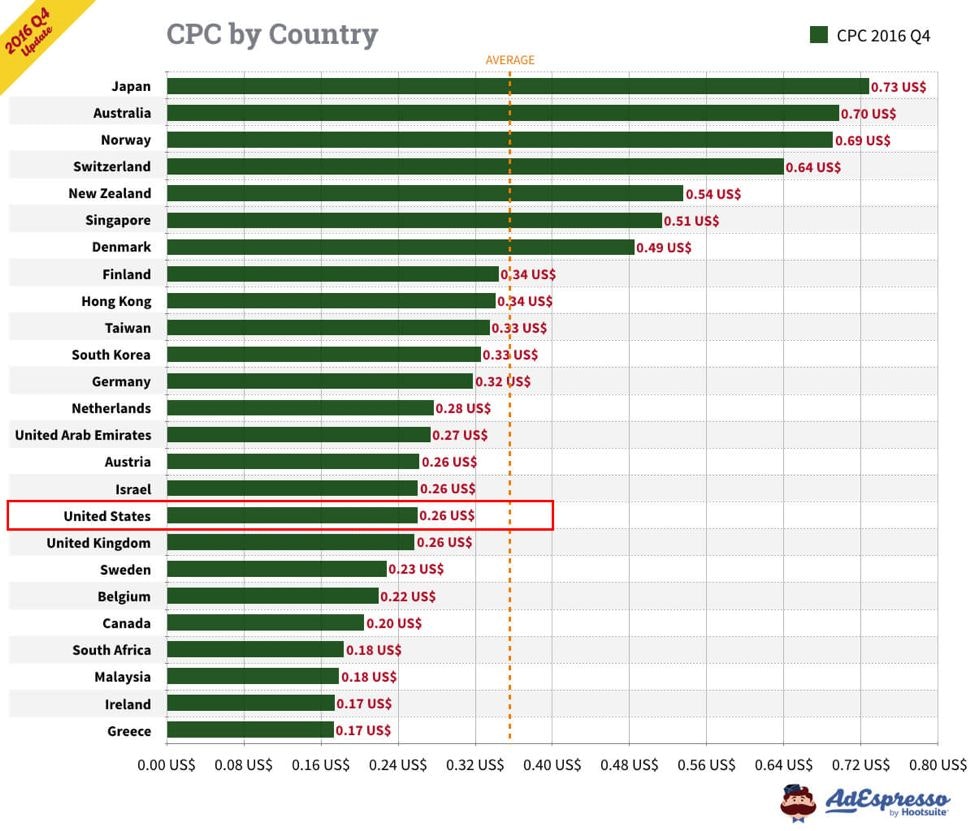
Naturally, costs have risen since a few years ago. But it’s safe to say that ad costs haven’t risen too much. $0.20 to $0.80 per click is still a good benchmark for your reference.
→ Click Here to Launch Your Online Business with Shopify
Many factors affect this CPC, as well as the Facebook CPM (cost per 1,000 impressions, or views, of your ad), including:
- Your audience targeting
- The engagement levels and relevance score of your ad
- The time of year
- Your campaign objective
- The maturity of your Facebook pixel
Let’s talk about each of these a bit more.
How your audience affects Facebook ads pricing
According to that same study by AdEspresso, it costs more to target people age 55-64 than to target people age 18-24.
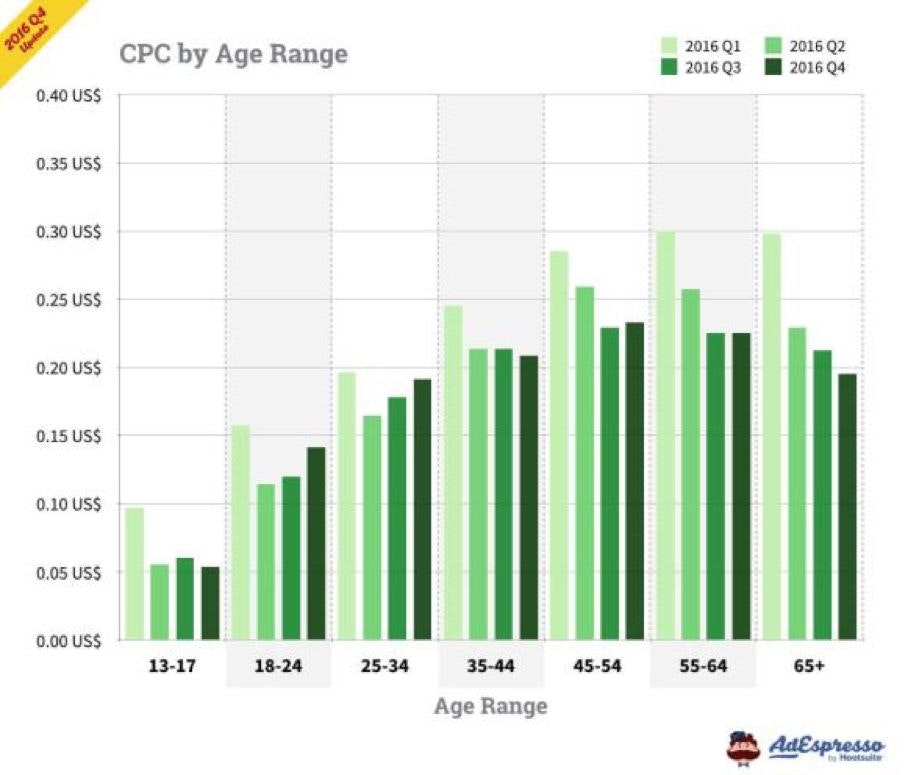
Additionally, women are more expensive to target with ads than men (for Facebook ‘likes’ at least).
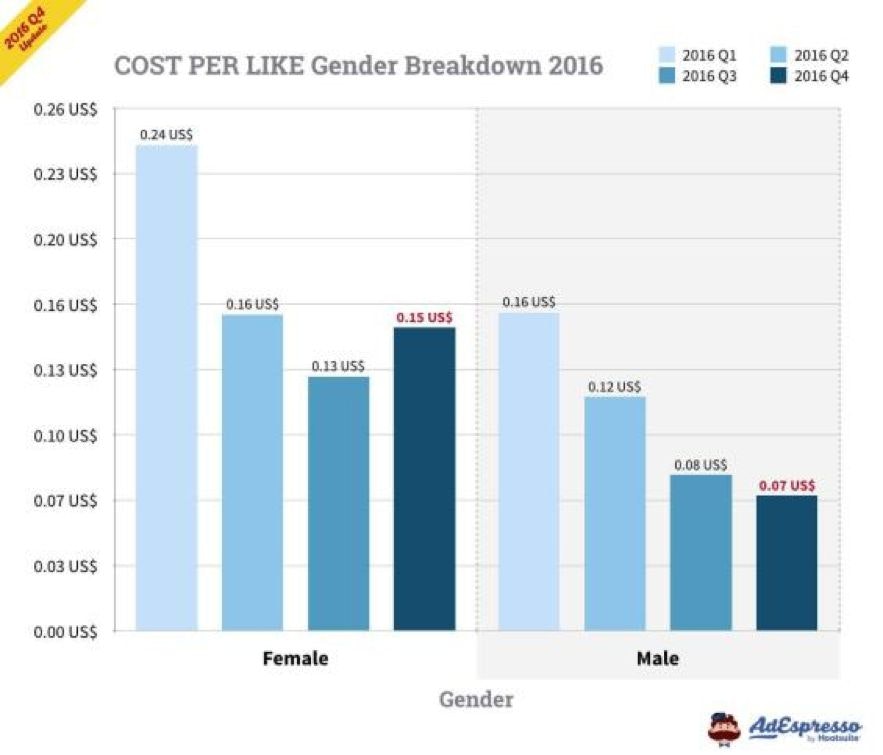
This doesn’t mean that you’ll struggle if you’re targeting women age 55-64; it just means you’ll need to work harder to nail down your offer and audience engagement to lower your Facebook advertising costs, which we’ll talk about in the next section.
We’ll also discuss audience targeting in-depth in Chapter 4.
How engagement and relevance score affect your CPC
You know how Facebook’s algorithm shows your posts to more people if it receives a lot of engagement shortly after publishing?
This holds true for Facebook ads as well. In fact, every ad you purchase receives a relevance score by Facebook based on that ad’s engagement and relevance to your audience.
For example, if you run a Facebook campaign about puppy food to people who hate puppies (that is, nobody), your CPC and Facebook CPM will be through the roof because your ad is completely irrelevant.
The higher your relevance score, the lower your CPC and the higher your click-through rate will be. In other words, more sales for less money.
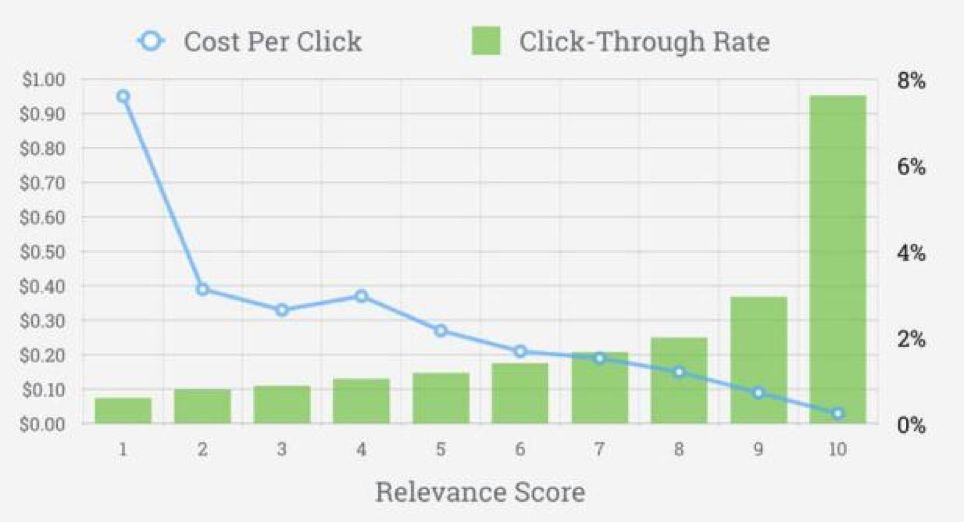
Look at the huge difference between a 9 and a 10: we’re talking almost triple the click-through rate with less than half the cost per click. A measly $0.03 per click!
How do you get a higher relevance score? We’ll cover that in Chapter 5 when we discuss optimizing your campaigns.
Time of year and Facebook ad costs
Facebook ads work on a bidding system, sort of like Facebook ad auctions. You place a bid on how much you’d like to spend per click. (Facebook does this automatically for you unless you use the advanced settings. More on that in Chapter 4.)
Because of this, when lots of marketers are buying Facebook campaigns at the same time, the bidding cost goes up. Specifically, during major shopping holidays like Christmas and Black Friday, Facebook CPC goes through the roof.
AdEspresso found that cost per app install skyrockets in November and early December, likely due to the holidays.
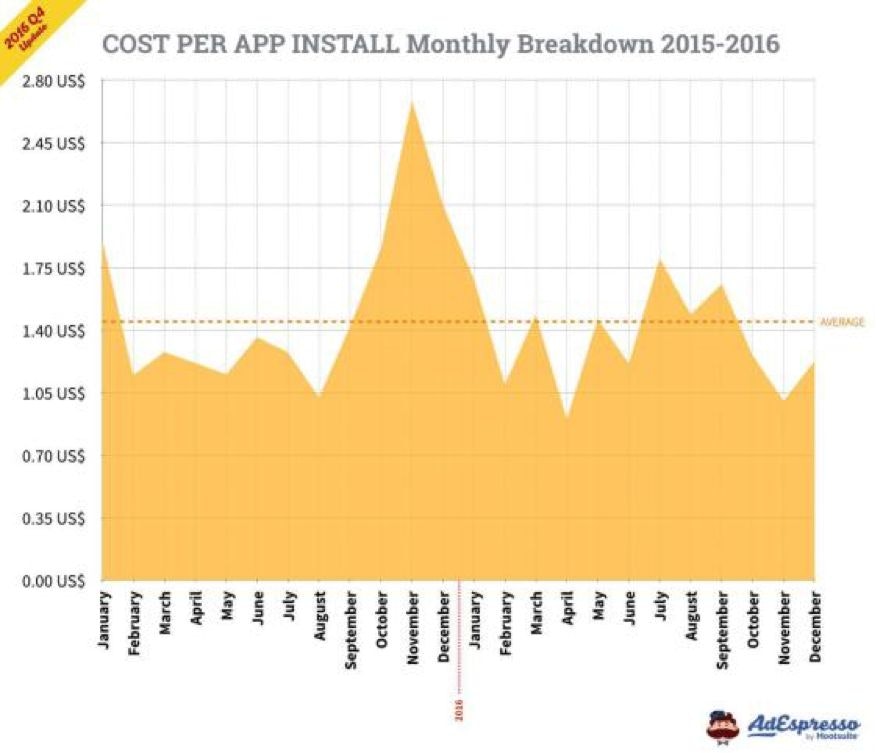
While not the same as CPC, cost per app install tends to increase and decrease in junction with CPC, so you can view the trends similarly.
The takeaway? Expect higher Facebook advertising costs during major holidays. If you don’t need to advertise during those holidays, allocate more of your advertising budget in the spring and summer months.
That said, if you still make a profit despite the higher costs (factoring in customer lifetime value, which we’ll cover in the next section), you should continue to run them year-round.
Your Facebook Campaign Objective and how it affects costs
Whenever you start a new campaign, you have to choose from a list of ad objectives.
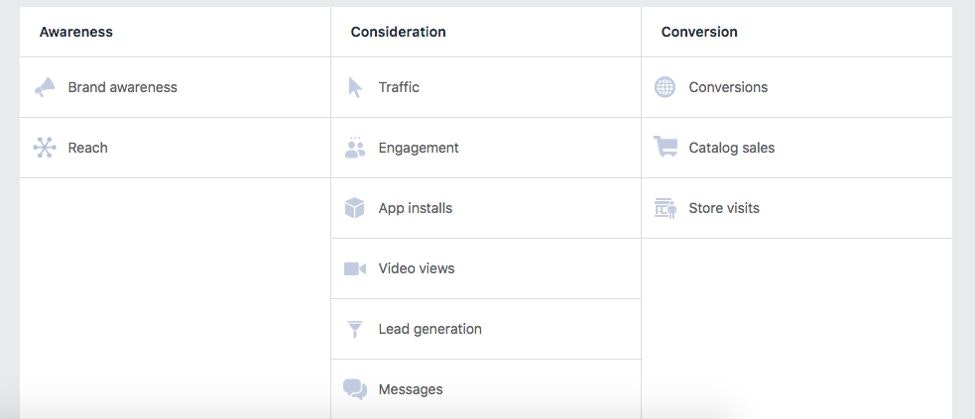
They fall into three categories:
- Awareness – when you just want people to know about you.
- Consideration – when people are aware of you and considering your product vs. a competitor’s product.
- Conversion – when people are ready to buy.
These objectives get progressively more expensive as you get closer to the sale. Reach and lead capture campaigns are the most expensive, which makes sense.
We’ll further discuss ad campaign objectives in Chapter 3.
How your Facebook pixel affects Facebook advertising costs
Your Facebook pixel is a snippet of code. You put this code on the pages of your site to collect data on whoever visits the site. We’ll discuss how to set it up and what it does further in Chapter 3, but for now, know this:
As your pixel collects data on the people who tend to click on and purchase from your ads, it uses machine-learning to learn who your best target market is. This is called ‘maturing’ your pixel, and it’s done simply by running ads over time.
As your pixel learns who your best customers are, it can improve your Facebook audience targeting to target people similar to past customers who are more likely to buy. This lowers your CPC while simultaneously increasing your click-through and conversion rates.
You can also use your pixel to run remarketing campaigns and create lookalike audiences, but you’ll learn all about that in Chapter 4. Just know that you definitely need to install the pixel if you want to run successful Facebook ads!
Now that you understand Facebook ads pricing, let’s talk about the important part – return on investment!
What’s the ROI on Facebook ads?
There are multiple case studies suggesting the average ROI of Facebook ads is somewhere around 400-450%.
Of course, that percentage varies massively by industry and the profit you make on your products or services. So take it with a grain of salt.
The real reason for this section isn’t to give you an exact number to expect as a return, but rather to set some expectations and explain how to calculate your own ROI.
Word of warning: It’s highly likely you will lose money on Facebook ads at first. In fact, many people continually lose money on their ads in order to get new customers, then make up for that loss with remarketing and lookalike audience campaigns.
To make sure you’re still making money in the long run, you need to understand your cost per acquisition (CPA) and your customer lifetime value (CLV).
CPA is how much you need to spend on ads before actually acquiring a customer. You need to know your conversion rate (CRV) to get this answer.
For example, if you need 10 clicks to get one customer, and your CPC is $1, your CPA would be $10.
Avg. # Clicks Per Sale * CPC = CPA
10 * $1 = $10
Your CLV is how much money you make over the lifetime of a customer.
If they spend $10 on that initial ad, you break even (or lose money if you have other costs). But if they come back to your store from a remarketing campaign and the CPA for the remarketing ad is only $2, then you make $8 ($10 – $2).
Avg. Order Value * # Of Orders Per Year * # of Years as a Customer = CLV
$10 * 10 * 1 = $100
If they purchase from you 10 more times over the course of a year, you made another $80. So with that math, your CLV from that customer is $110, with an $80 profit (before other costs).
CLV – (CPA * # of Sales) = Profit
Or, if you want to get fancy:
CLV – Initial CPA – (Remarketing CPA * # of Sales) = Profit
In other words, despite losing a few dollars on the initial ad, you made $80 in profit from that customer over the course of a year. See how that works? That’s why it’s important to understand your numbers.
We’ll talk more about numbers and metrics in a second. For now, let’s do a quick recap.
Quick recap: What affects your Facebook ad costs and ROI?
To tie it all together, in order to avoid losing money on Facebook ads, you need to understand your CPC, CPM, CPA, and CLV.
The average CPC is somewhere between $0.20 to $0.80 depending on the ad location, time of year, audience, and relevance. Just to give you some rough benchmarks.
Your CLV can be calculated by adding up all the purchases of a customer over their lifetime (the time from their first purchase to their last). Do this for a handful of customers, add them all up, then divide by the number of customers you did the math for. That’s your CLV.
Now that you know what affects Facebook advertising costs and how to calculate your necessary ROI, let’s set up a few goals and deliverables to keep your campaigns on track.



Deciding on your goals and KPIs
As they say, what gets measured, gets managed.
Having clear, written goals and deliverables on your Facebook ads makes it easier to know if you’re on track, or if you need to make changes to your campaign.
Key performance indicators (KPIs) are metrics, such as engagement, CPC, number of likes, etc., which you can use to compare your performance.
Which KPIs you choose depends on your goals. Do you want to:
- Increase brand awareness? Use the ‘brand awareness’ objective and measure impressions.
- Increase engagement? Use the ‘engagement’ objective and measure likes, comments, and shares.
- Capture leads? Use the ‘lead generation’ objective and measure leads captured.
- Increase sales? Use the ‘conversions’ objective and measure sales made.
We’ll discuss the objectives you should use based on campaign type in Chapter 3, but for now it’s a good idea to know what your overall goal is for your Facebook campaign.
The absolute must-track metrics, if you want to calculate your ROI, are your CPA and conversion rate (CVR). Your CPC, engagement, and impressions are all vanity metrics in comparison.
This is because CPA and conversion rate are the two metrics required to calculate true ROI.
Let’s say we have two campaigns – A and B. If we compare them in terms of CPC and pure clicks, we might get something like this:
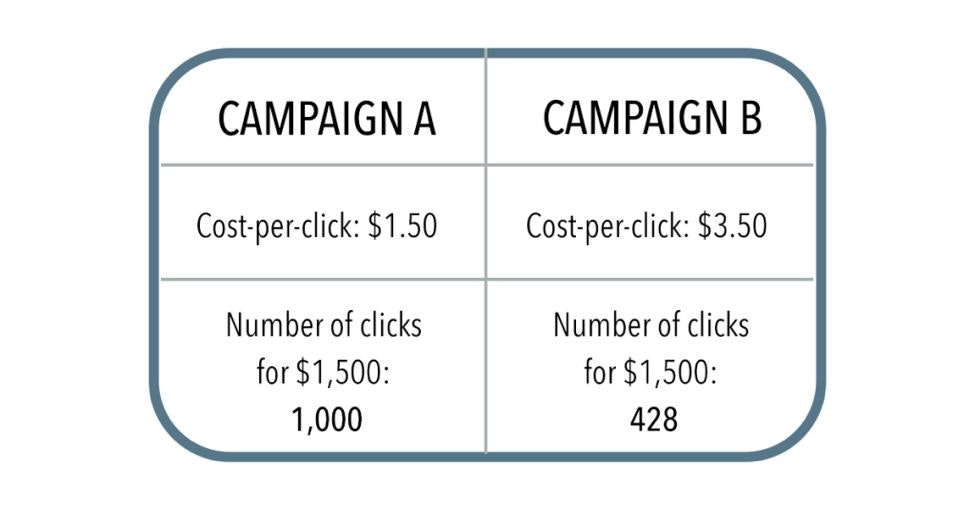
It looks like Campaign A wins, right? But let’s factor in the conversion rate (CVR):
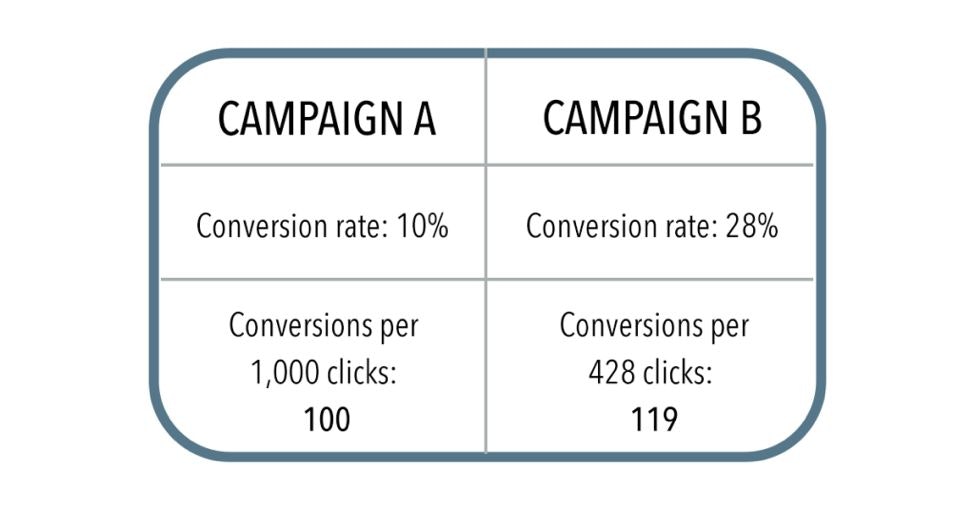
Now you see that despite having a higher CPC and fewer clicks, Campaign B actually brought us more conversions for the same ad spend.
This is why it’s important to decide on an objective and which KPIs you’ll measure ahead of time, and to always prioritize CPA and CVR unless you’re just running ads for brand awareness.
Go ahead – write down your goals and KPIs in a Google Sheet or Word doc now. For example, you may have the goal of increasing sales with a 20% CVR and $10 CPA.
